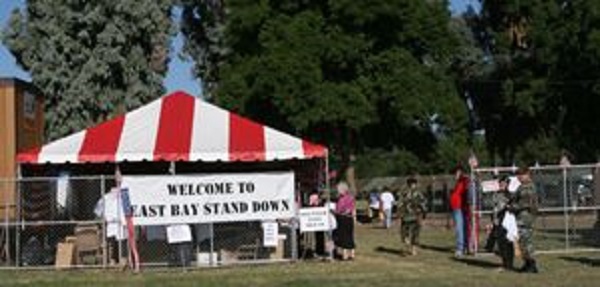One of the reasons that military veterans don’t get more help is that they get forgotten. Many of them were low-profile before they entered military service, and even lower-profile after they came home, often with physical injuries or mental trauma. Not surprisingly, the ones with the worst problems are often homeless or otherwise at-risk. And unfortunately, these homeless and at-risk ones get little or no publicity about their plight. Fortunately, Bob Sitzwohl, a volunteer at the Midpen Media Center, has done something to publicize it, by creating a video called “East Bay Stand Down: Forgotten Faces” that is now live on YouTube and playing on PEG channels 26, 27, 28, 29 and 30. And he knows whereof he speaks, as he himself was homeless when he left the Navy in the mid-to-late 1970’s.
(According to the U.S. Department of Veterans Affairs, Stand Downs are just one part of the efforts to provide services to homeless Veterans. Stand Downs are typically one to three day events providing services to homeless Veterans such as food, shelter, clothing, health screenings, VA and Social Security benefits counseling, and referrals to a variety of other necessary services, such as health care, housing, employment, and substance use treatment. Stand Downs are collaborative events, coordinated between local VAs, other government agencies, and community agencies serving the homeless.)
Tag Archives: Housing
Menlo Park, CA VA Campus to Construct “Affordable” Housing for Homeless and At-Risk Veterans

It makes sense to use some land already controlled by the U.S. Department of Veteran Affairs (VA) to build apartments for use by veterans. And it seems to be a nice bit of cooperation among the VA, CORE Affordable Housing, and the City of Menlo Park. Housing costs in this area are among the highest in the U.S. The 60 units include studio and one-bedroom apartments, with rent ranging from $574 to $792. These rates would permit people to live close to their work; many people have to commute an hour or more to find rentals at these levels. Presumably homeless people do not have regular jobs, so they need help paying the rent, for which there are several federal programs, such as those from the Department of Veteran Affairs and private programs such as those from Volunteers of America. Truly homeless or at-risk people may also need help finding jobs or getting enough training or education to qualify for those jobs. But that is another story.
Decline in Qualified Military Enlistee Volumes Puts Further Pressure on Taking Care of Returning Veterans
The armed forces have long been a default choice for young adults who aren’t prepared for, or cannot choose, a different occupation. One of the more unusual enlistees, author Tom Robbins, explains his reasoning in his new autobiography, Tibetan Peach Pie: “Why? – one might fairly ask. Well, for precisely the same reason the 90 percent of all enlistees join the military, which is to say, I was at a point in my life when I didn’t know what else to do.” Unfortunately, the number of qualified enlistees continues to decline because so many (71%) of the 34 million 17-24-year-olds in the U.S. don’t meet the basic standards of education, fitness (many are very obese), and absence of visible tattoos, according to The Wall Street Journal. The tattoo requirement is because not only do these youths have to be able to fight but also they have to look good in uniform. This seems like a frivolous requirement when put into the perspective of their fellow soldiers who have been physically injured or mentally traumatized in actual combat. And with the increasing number of injured/traumatized vets not being properly cared for these days, and thus not willing or able to re-enlist, the U.S. military is going to be hard-pressed to defend our country.


